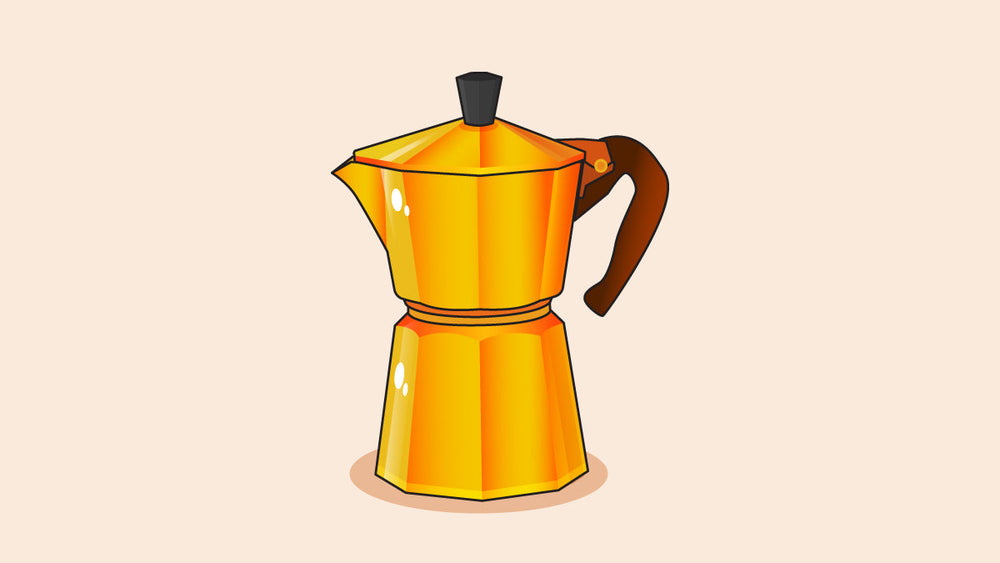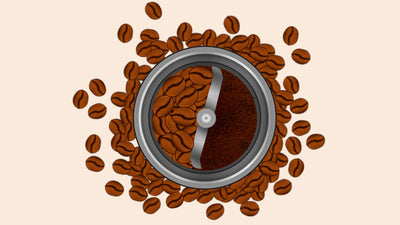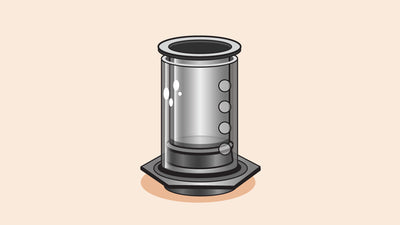The moka pot is a classic Italian brewing appliance designed for the stovetop. It uses heat and pressure to brew a dark, rich, coffee similar to espresso — without the need for expensive equipment. You can even develop a light crema with a moka pot if you brew it just right.
This brewing device is super easy to use, produces coffee as fast as you can boil water, and comes in all different sizes — from single-servings all the way up to ten cups or more.

Moka Pot Brewing Specs
- Brew Time: 5–10 minutes
- Coffee/Water Ratio: 1:10
- Grind: Fine Grind (like sand)
- Water Temperature: 208ºF (98ºC)
- Recommended Coffee: Saigon OG, Da Lat
Moka Pot Brewing Summary
- Measure & grind your coffee.
- Assemble your moka pot.
- Wait for the pot to start brewing.
- Turn down the heat & allow your pot to finish brewing.
- Pour, mix with milk, sweetener, or more hot water & enjoy.
Tools You’ll Need
To brew coffee using a moka pot, you’ll need the following items/ingredients:
- Moka Pot — The Moka Pot is available in many shapes and sizes. The larger sizes are easier to regulate and produce a nice, even crema in the final cup.
- High-Quality Coffee — Opt for higher-quality arabica for this brewing device. Robusta coffee comes out very bitter with this device, so be prepared to add a lot of sweetener. Try our DaLat (100% arabica) for a delicious cup of moka coffee.
- Stove Top — The Moka Pot is heated directly using a stovetop. You don’t need a kettle for this style of brewing.
- Coffee Grinder — A burr grinder is preferred and will provide the best grind consistency, but a blade grinder or a small blender will do the trick too. Aim for a fine grind with a coarseness similar to sand.
- Hot Water — For the moka pot, you'll want to opt for a ratio of around 1:10 coffee to water. The total amount of water will depend on the size of your pot.
Step-By-Step Instructions: Moka Pot
Here’s a simple process for brewing coffee using an Italian moka pot.
The main thing to watch out for when brewing with this device is not to let it boil and bubble on the stove for too long once it’s finished. As long as you take it off the heat at the right time, you’ll end up with a delicious espresso-style coffee.
Step 1: Measure & Grind Your Coffee

The amount of coffee you’ll need will depend on the size of your moka pot (chart below). These pots are sized according to the number of espresso shots they produce — a 1-cup pot makes 1 espresso shot, a 2-cup pot produces 2 shots, etc.
Grind your coffee to a fine grind (similar consistency to sand). A burr grinder is recommended for this, but blade grinders work fine as well.
Alternatively, you can purchase your coffee pre-ground to skip this step.
Moka Pot Coffee to Water Ratios
|
Moka Pot Size |
Espresso Shot Equivalents |
Coffee |
Water |
|
1-Cup Moka (60 mL) |
1 espresso shot |
6 grams |
60 mL |
|
3-Cup Moka (200 mL) |
3 espresso shots |
20 grams |
200 mL |
|
6-Cup Moka (300 mL) |
6 espresso shots |
30 grams |
300 mL |
|
9-Cup Moka (550 mL) |
9 espresso shots |
55 grams |
550 mL |
|
12-Cup Moka (775 mL) |
12 espresso shots |
77 grams |
770 mL |
Step 2: Assemble Your Moka Pot

Fill the bottom chamber with water up to the fill line, or about 1/2 inch (1–1.5 cm) from the top.
Insert the filter basket into the water chamber and fill it with your coffee. Add just enough coffee to fill the basket just below the top and level it out without compressing.
Next, screw on the top half of the pot securely and set it on the stovetop.
Step 3: Wait For the Pot to Begin Brewing

Turn the heat on and wait for it to start making a distinct gurgling noise. This can take anywhere from 2–10 minutes depending on your stove and the size of your moka.
If you're using a gas stove, ensure the flames sit at the bottom of the pot and don't extend up the sides.
Step 4: Reduce the Heat Once the Pot Starts Brewing

When the pot starts gurgling and the coffee starts to dribble into the top chamber, reduce the heat to the lowest setting. This prevents the coffee from burning and becoming bitter.
Watch as the coffee continues to dribble for about a minute or two. You’ll know it’s done when it starts sputtering loudly.
Step 5: Pour, Mix, & Enjoy!

Treat your moka brew like an espresso. You can drink it straight up for a concentrated black espresso-style coffee, mix it with more hot water to make an American, steamed or frothed milk for lattes or cappuccinos, or sweetened condensed milk for Vietnamese-style coffee (kept hot or poured over ice to cool).
Expert Tips When Using the Moka Pot
The beauty of the moka pot is that it makes espresso-style coffee available for a low upfront investment. However, just like traditional espresso, it does require some practice to make the perfect cup of coffee.
Here are some tips to make the perfect coffee using an Italian moka pot:
1. Don’t Leave it on the Stove Too Long!
This applies to any brewing method! Overheating results in bitterness and harsh flavors. Once your moka pot starts gurgling, turn the heat way down and remove it as soon as the upper chamber starts to sputter.
2. Get The Grind Right
The ideal grind for a moka pot is medium-fine or fine. If you like your coffee as strong as possible, go with a fine grind. If you prefer something a little smoother, both medium-fine or medium-grind work great.
Feel free to play around with the grind of your coffee until you find a taste that suits you.
A (Brief) History of the Moka Pot
The moka pot was invented by the Italian engineer Alfonso Bialetti in 1933.
His creation revolutionized coffee brewing forever by providing, for the first time ever, a method to make espresso-like coffee at home without the need for expensive machinery.
The moka pot was named after the Yemeni city of Mocha — which is considered the birthplace of coffee.
This stovetop brewer uses steam pressure to push water through coffee grounds, creating a strong and flavorful cup. Over the past 9 decades, it’s become an icon for Italian design and ingenuity.
Moka Pot FAQs & Troubleshooting

1. What type of coffee grind should I use for a moka pot?
A fine to medium grind is recommended coffee for moka pots. The grind should be slightly coarser than what you'd use for an espresso machine but finer than for a drip coffee maker. Use a consistency similar to sand.
2. How much coffee & water should I use in a moka pot?
Your moka pot should come perfectly sized for the water-to-coffee ratio. Just fill up the coffee basket so it’s flush with the top and the water until it’s just below the safety release valve.
This typically equates to a 1:10 coffee-to-water ratio by weight but can vary slightly depending on the make and model of your moka pot. You can reduce the volume of coffee for a slightly lighter brew.
3. What is the ideal heat setting for brewing with a moka pot?
Use a low to medium heat setting. High heat can cause the water to rush through the coffee grounds too quickly, leading to under-extraction and a bitter taste. Lower heat ensures a gradual and even extraction. It’s best to reduce the heat once the coffee starts coming out of the top spout to ensure a nice, smooth extraction.
4. Why does my moka pot coffee taste bitter?
Bitterness can result from over-extraction, which may occur if the heat is too high, the coffee is ground too finely, or the coffee is left on the heat for too long after brewing. Adjusting these variables can help reduce bitterness.
5. Can I make espresso with a moka pot?
While moka pot coffee is often referred to as "stovetop espresso," it doesn't produce true espresso in the technical sense, as it operates at a lower pressure than a “true” espresso. However, the moka pot does make a strong, concentrated coffee that’s similar to espresso and can be used as a base for espresso-style drinks like cappuccinos and lattes. If you want something closer to espresso, the Bialetti Brikka is a popular upgrade — designed to create more pressure and crema than a standard moka pot.
6. How do I clean my moka pot?
After each use, disassemble your moka pot and wash all parts with warm water and mild detergent. Avoid using abrasive materials that can scratch the surface. Allow your pot to dry completely before reassembling. Aluminum moka pots should never be washed in the dishwasher as this can cause oxidation.
7. Is it safe to use an aluminum moka pot?
Yes, it’s safe to use an aluminum moka pot — millions of people drink from these pots every day. While there has been some concern about aluminum cookware, there’s no conclusive evidence to suggest that using aluminum pots pose a health risk.
8. How long does it take to brew coffee with a moka pot?
The brewing process typically takes about 5 to 10 minutes from the moment you put the pot on the stove to when the coffee finishes brewing. This depends on the size of the moka pot you’re using and the heat source.
9. Can I use a moka pot on an induction stove?
Not all moka pots are suitable for induction stoves. Only magnetic-grade stainless steel will work on an induction stove. Aluminum moka pots will not work without an induction stovetop adapter.
















